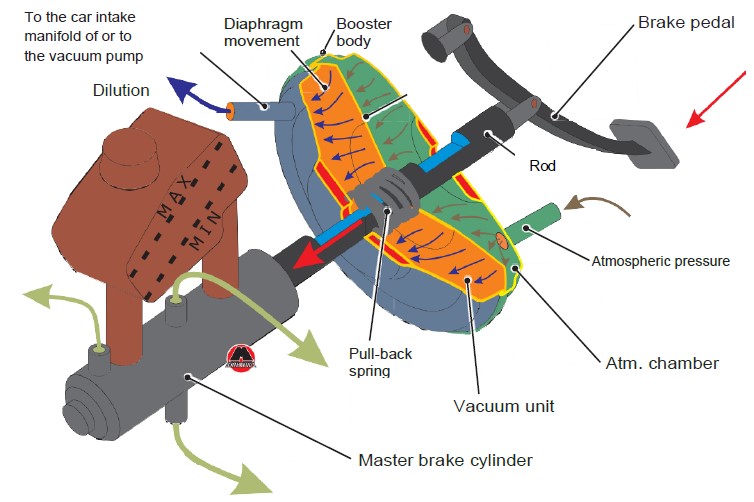7.2.8 Vacuum brake booster
The greater the weight of the car, the more effort was required in order to apply the brake pedal for reducing the speed or stopping the car effectively enough. It would be an unforgivable mistake not to use the physical processes that occur during engine operation No mistakes were made - a vacuum booster was installed. Why is it vacuum? It uses the vacuum, which is created inside the engine intake manifold. The device of such booster is simple (figure 7.7): there is a case, which is divided by a diaphragm into two chambers - vacuum and atmospheric. On the brake pedal rod, inside the booster, there is a follow-up valve*, which opens or closes the access of atmospheric pressure to the atmospheric chamber. In addition, a pull-back spring of the amplifier diaphragm is installed. Master brake cylinder is consistently installed after the booster.
*Follow-up valve is not shown in Figure 7.7 for the ease of perception.

Figure 7.7 Vacuum booster of brakes in assembly with brake pedal and master brake cylinder.
Примечание
Due to various design features of the engines, the vacuum can be supplied not only from the intake manifold, but also from a special vacuum pump. For example, a vacuum pump is used for all diesel engines, because they have a small amount of vacuum in the intake manifold.
How does it work? This is quite simply: in the initial position (when no one is going to brake) the pressure in both chambers is the same and equal to the pressure, which is created inside the intake manifold. As soon as there is a need to brake, you will need to press the brake pedal. The movement of the pedal will be transmitted through the push rod to the follow-up valve. This valve will close the channel, which connects the atmospheric chamber with the vacuum unit. Further movement will connect the atmospheric chamber with the atmosphere. There will be a pressure drop, which will start acting on the diaphragm and move it, overcoming the force of the return spring. And the diaphragm, in turn, will move the piston rod of the master brake cylinder.
Примечание
This design of the vacuum booster provides a significant increase of the force (it can reach five times the magnification) on the piston rod of the master brake cylinder, which is proportional to the force on the brake pedal. In a word: the harder you press the pedal, the stronger and more efficient the vacuum booster will work.
As soon as the driver releases the brake pedal, the bleeder valve will close. The pressure in both chambers of the booster will be equalized, and the diaphragm will return to the initial position under the action of a pull-back spring.



















2 MB